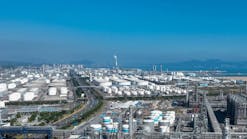Petrochemical Report Revamp of Ukraine VCM plant will boost capacity,Lreduce emissions
Oriana Concern (formerly P.O. Chlorvinyl) is revamping its 250,000 metric ton/year (mty) vinyl chloride monomer (VCM) plant at Kalusch, Ukraine.
At the core of the project are a new ethylene dichloride (EDC) cracking furnace and direct chlorination unit, and revamp of an oxychlorination unit to use oxygen rather than air.
The plant expansion and modernization will boost capacity to 370,000 mty. New facilities for by-product recycling and recovery, waste water treatment, and emissions reduction will improve the plant's environmental performance.
Table 1 [14032 bytes] shows expected feedstock and utility consumption for VCM production.
Techmashimport and P.O. Chlorvinyl commissioned the Kalusch plant in 1975. The plant was built by Uhde GmbH, Dortmund, Germany.
Fig. 1 [69930 bytes] is a schematic of the Hoechst/Uhde VCM process being used for the plant revamp. The diagram is divided into processing sections.
Section 1
In Section 1 of the plant, EDC is produced by direct chlorination of ethylene. This exothermic reaction is represented by Equation 1 (Reactions).
The unit is designed to produce 99.8-99.9% pure, gas-phase EDC. This processing scheme eliminates the need for water washing and subsequent drying. As a result, no waste water is produced by the unit.
The Hoechst Chlorination with Energy Recovery (CER) process uses a complex, iron-based catalyst, rather than the conventional FeCl3. The catalyst suppresses the formation of by-products and allows reaction at substantially higher temperatures, says Uhde's Hans G. Kraus. And, because of the noncorrosive nature of the catalyst, ordinary steel can be used for vessel fabrication.
Reduced by-product formation decreases the size of the associated recovery facilities. As a result, offgas production from recovery operations is reduced.
Oriana Concern will use excess reaction heat from the direct chlorination process to heat distillation columns, thus reducing steam, cooling water, and energy consumption.
Section 2
In Section 2 of the plant, ethylene is chlorinated via the oxychlorination route in a highly exothermic reaction (Equation 2). Conversion to EDC is catalyzed at a temperature of more than 200 C.
Ethylene conversion is expected to be 99.0%.
"The oxygen-based process substantially reduces the volume of reactor offgas that needs to be purged in order to prevent the accumulation of impurities (carbon oxides and nitrogen)," says Kraus. In fact, offgas production is 1-2% of that from an air-based oxychlorination unit.
The oxychlorination reaction takes place in a fluidized bed. A sparger and distribution grid disperse the catalyst and reaction gases and eliminate the formation of hot spots. This even distribution maintains a constant temperature in the reactor, thus reducing by-product formation and improving process control.
The heat of reaction is dissipated by internal cooling coils and used for steam generation. The offgases are sent to the HCl recycle unit.
Raw EDC (99.5% pure) is removed from the reaction gases by multistage condensation. An EDC distillation unit removes impurities from the raw product to produce feed-quality EDC (99.8% pure).
The water produced by the reaction is removed in the downstream quench column. The water phase contains small quantities of chlorinated hydrocarbons and sodium chloride. This stream is treated in the waste water treatment unit, and the organic phase and offgas are sent to HCl recovery.
The dry bottoms from the dewatering column are separated from high-boiling constituents in two downstream columns: a so-called "high-boil" column and a vacuum column. The bottoms product from the vacuum column also is sent to HCl recovery.
Section 3
The purified EDC is cracked in Section 3 of the process to form VCM (Fig. 1 [69930 bytes]). This reaction is represented by Equation 3, and takes place in a furnace at temperatures greater than 480 C.
The reaction is endothermic and incomplete. Oriana will use the heat from the cracked gas for external EDC evaporation and superheating of feed EDC. The use of evaporation and superheating reduces coke formation in the furnace and decreases energy consumption drastically.
As a result of reduced coking, operating periods between furnace decokings are expected to be 1 year or more, says Kraus. In addition, on-stream time and reliability will be improved, and cracking rates for the unit should approach 65%.
The VCM product stream is processed through an HCl column before entering the VCM column. The recovered HCl is recycled to the oxychlorination unit.
The bottom product from the VCM column, unconverted EDC, is chlorinated, then recycled to the EDC distillation unit. The distilled VCM is then sent to a stripper, which reduces the HCl content in the product to less than 1 ppm.
Emissions reduction
By-products from the VCM production process are oxidized completely to form CO2, water, and HCl. Oxidation occurs in an excess of air at about 1,250 C. Heat from the combustion gases is used to generate medium-pressure steam, and the HCl is recovered and returned to the oxychlorination unit.
In the waste water treatment unit, chlorinated hydrocarbons are removed by distillation. The HCl in the waste water is neutralized with caustic soda solution, and the metal salts are removed by flocculation, sedimentation, and filtration.
Liquid EDC and VCM from drains, filters, reboilers, and other process equipment in the plant will be collected in a closed system and returned to the process loop.
Continuous sources of waste gas are connected to waste gas headers. The gases are then sent to the HCl recovery unit.
The Kalusch modernization project also includes such emissions prevention devices as:
- Pumps equipped with double mechanical seals or glandless drives
- Closed sampling systems
- Alarms and automatic-shutdown systems to reduce relief-valve emissions.
Commissioning
Uhde is providing engineering, procurement, and commissioning supervision for the project. Civil and detail engineering for the equipment fabricated in the Ukraine were provided by Gipropolymer, a company based in Dzerzhinsk, Russia, and owned 76% by Uhde.
Uhde is supervising construction, which, along with procurement of local equipment, is being performed by Oriana Concern. Individual plant sections will be handed over to Oriana in phases.
Start-up of the modernization project is scheduled for year-end 1996.
Copyright 1996 Oil & Gas Journal. All Rights Reserved.


